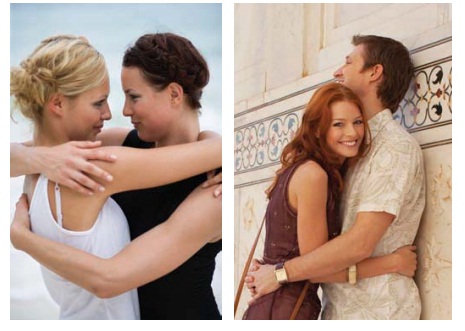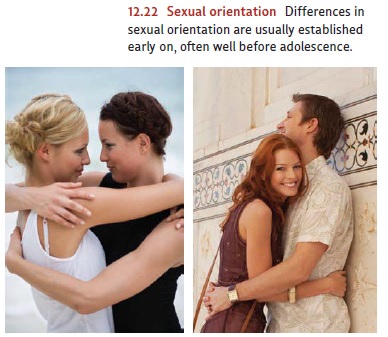Chapter: Psychology: Motivation and Emotion
Sexual Orientation

Sexual Orientation
So
far, we have touched upon many different physiological and social aspects of
sexual behavior. However, up to this point, we have neglected one very
impor-tant question: What determines our sexual orientation?
The
roots of someone’s sexuality are established well before ado-lescence. As early
as age 3 or 4, children start to have feelings of attrac-tion (Bell, Weinberg,
& Hammersmith, 1981). The first real sexual attraction, however, usually
begins by age 10 or so (Herdt & McClintock, 2000), and children of this age
often imagine star-struck romances (R. Green, 1979; Zuger, 1984). These
feelings soon crystallize, and, by early adolescence, with the onset of puberty
and an increased emphasis on social relations outside the family, sexual
orientation becomes explicit, and actions based on the orientation become
common (Figure 12.22).
How
common is each of the sexual orientations—heterosexual, homosexual, or
bisexual? Years ago, Alfred Kinsey and his associates reported that more than
80% of American men describe themselves as exclusively heterosexual and 4% as
exclusively homosexual

(Kinsey,
Pomeroy, & Martin, 1948). The prevalence of exclusive homosexuality
reported by women was lower—about 2% (Kinsey, Pomeroy, Martin, & Gebhard,
1953). A sub-stantially larger group (13% of American men and 7% of women)
described themselves as predominantly homosexual but had also had some
heterosexual experience. More recent surveys confirm Kinsey’s estimates, both
in the United States and in other Western cultures (see, for example, ACSF
Investigators, 1992; A. M. Johnson, Wadsworth, Wellings, Bradshaw, & Field,
1992; for some complications, though, see Savin-Williams, 2006).
What
makes a particular individual homosexual, heterosexual, or bisexual? There is
clearly a genetic influence, because it turns out that if a man’s identical
twin is gay, then the chances that he will also be gay are 52%; if the gay twin
is fraternal, the chances drop to 22% (Bailey & Pillard, 1991). Likewise, a
woman’s chance of having a homosex-ual orientation is 48% if she has a lesbian
identical twin. If her gay twin is fraternal, the chances drop to 16% (Bailey,
Pillard, Neale, & Agyei, 1993). Clearly, then, the greater the similarity in
genetic makeup, the greater the likelihood of having the same sexual
ori-entation, powerfully suggesting that one’s genotype carries a
predisposition toward heterosexuality or homosexuality.
But
how do genes influence sexual orientation? The mechanism probably involves the
levels of prenatal hormones, especially the male hormone androgen. Part of the
evidence on this point comes from androgenized females—those who were exposed
in the uterus to high androgen levels—who are far more likely than others to
describe themselves as homosexual or bisexual (37%). In these women, the high
androgen levels are produced by a specific genetic pattern, but the same
hormonal patterns can be produced by many other factors. In all cases, these
shifts in hormone levels during pre-natal development seem to influence sexual
orientation (Dittman, Kappes, & Kappes, 1992; Ellis & Ames, 1987;
Hines, 2004; Zucker, 2001).
If
genes were the whole story, though, then identical twins (with 100% of the same
genes) would show 100% resemblance in their sexual orientation; instead, the
concor-dance rate is just 52%. Obviously, therefore, factors other than the
genes matter, but no one is yet sure what these other factors are. Many
hypotheses have been offered, but most of these are plainly wrong. For example,
there is no evidence that especially strong fathers, or especially weak
fathers, are more likely to have homosexual offspring. There is also no
evidence that homosexuality derives from some sort of imitation; children who
grow up with gay or lesbian parents are no more likely to be homosexual
them-selves (M. Bailey & Zucker, 1995; Golombok & Tasker, 1996).
What
we do know is that the main predictor of adult homosexuality is the way people
felt about sexuality when they were younger. As we mentioned earlier, sexual
orientation can be detected in middle childhood—and certainly before the
individ-ual experiences any sexual encounters, homosexual or heterosexual.
Indeed, people of any sexual orientation might well identify with the sentiment
voiced by many homosexuals when they report simply that “I’ve been that way all
my life” (Saghir & Robins, 1973).
Overall,
then, we still have much to learn about what makes someone homosexual,
heterosexual, or bisexual. Genes are certainly relevant, but we are still
figuring out what the rest of the story involves. Whatever the origins of
sexual orientation, though, it bears emphasizing that a homosexual (or
bisexual) orientation is not a psychological disorder or defect. These
orientations are “abnormal” only in the limited sense of being different from
the majority. Many other traits are “abnormal” in exactly the same sense—being
left-handed, for example. Gays, lesbians, and bisexuals are neither better nor
worse than heterosexuals, and the factors that matter for their relationship
quality and stability seem to be exactly the same as those that matter for
heterosexual couples (Kurdek, 2005). Their number includes great painters
(Leonardo da Vinci), athletes (Martina Navratilova), musicians (Aaron Copland),
writers (Oscar Wilde, Gertrude Stein), mathematicians and scientists (Alan
Turing, Alfred Kinsey himself ), philoso-phers (Wittgenstein), and warriors
(Alexander the Great), but the great majority are ordinary people with ordinary
lives. The same no doubt holds for left-handers—and for heterosexuals.
Related Topics